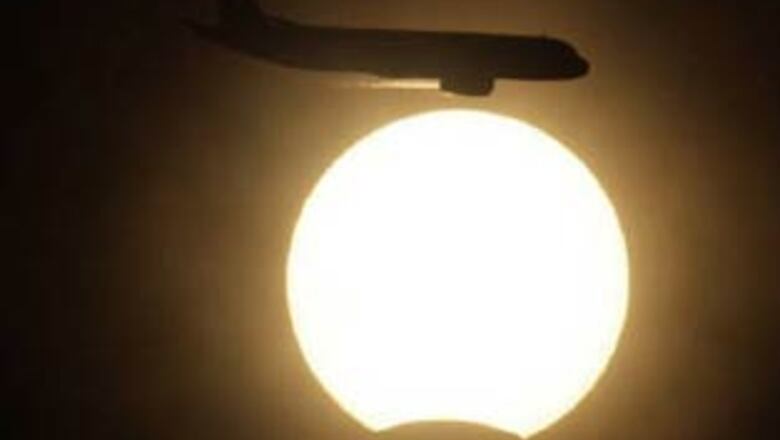
views
Varanasi/Wuhan, China: A total solar eclipse began its flight on Wednesday across a narrow swathe of Asia, where hundreds of millions of people watched the skies darken despite thick summer clouds.
The longest total solar eclipse of the 21st century was visible along a roughly 250 km-wide corridor, according to the US space agency NASA, as it travelled half the globe and passed through the world's two most populous nations, India and China.
Thousands of people snaked through the narrow lanes of the ancient Hindu holy city of Varanasi and gathered for a dip in the Ganges, an act considered as leading to salvation from the cycle of life and death.
Amid chanting of Hindu hymns, men, women and children waded into the river with folded hands and prayed to the sun as it emerged in an overcast sky.
"We have come here because our elders told us this is the best time to improve our after-life," said Bhailal Sharma, a villager from central India who came to Varanasi with a group of about 100 people.
The eclipse then swept through Bangladesh, Nepal, Bhutan, Myanmar and over the crowded cities along China's Yangtze River, before heading to the Pacific.
Crowds gathered along the high dykes of Wuhan, an industrial city in central China, roared and waved goodbye as the last sliver of sun disappeared, plunging the city into darkness.
"As soon as the totality happened, the clouds closed in so we couldn't see the corona. That's a pity," said Zhen Jun, a man whose work unit had given the day off for the spectacle.
But eclipse viewers in central China was luckier than those in the coastal cities near Shanghai, where overcast skies and rain in some places blocked the view of the sun entirely.
Longest this century
Eclipses allow earth-bound scientists a rare glimpse at the sun's corona, the gases surrounding the sun.
"In the 21st century this is the longest," said Harish Bhatt, dean at the Bangalore-based Indian Institute of Astrophysics.
"This is indeed quite an important event for scientific experiments. Its long duration provides you an opportunity to make very complicated, complex experiments."
Scientists in China planned to snap two-dimensional images of the sun's corona -- up to 2 million degrees Celsius (3.6 million F) hot -- at roughly one image per second, Bhatt said.
The eclipse lasted up to a maximum of 6 minutes, 39 seconds over the Pacific Ocean, according to NASA.
The eclipse is seen as a mixed blessing for millions of Indians. Those who considered it auspicious bathed in holy rivers and ponds for good fortune during the solar blackout.
But astrologers predicted the eclipse spelled bad luck for others. Expectant mothers asked doctors to advance or postpone births to avoid complications or a miserable future for their children.
Parents in several schools in New Delhi kept their children home from classes since the eclipse coincided with breakfast. According to Hindu custom, it is inauspicious to prepare food during an eclipse.
In ancient Chinese culture, an eclipse was an omen linked to natural disasters or deaths in the imperial family. Chinese officials and state media were at pains to reassure the public that city services would run normally.
"We heard about it on television last night," said Qian Qiangguo, speaking in a thick Wuhan accent.
In modern China, people who wished to see the astronomical rarity clearly tried to escape thick pollution caused by the rapid industrial growth, avoiding cities where smog smudges the horizon, even on clear days.
"The majority of people decided to go to Tongning, in Anhui, because they're worried about the serious air pollution from industrial areas in Shanghai," said Bill Yeung, the president of the Hong Kong Astronomical Society, who organised 120 eclipse chasers from Hong Kong.
Those who chose Shanghai ended up fleeing to inland cities to escape the clouds, he added.




















Comments
0 comment